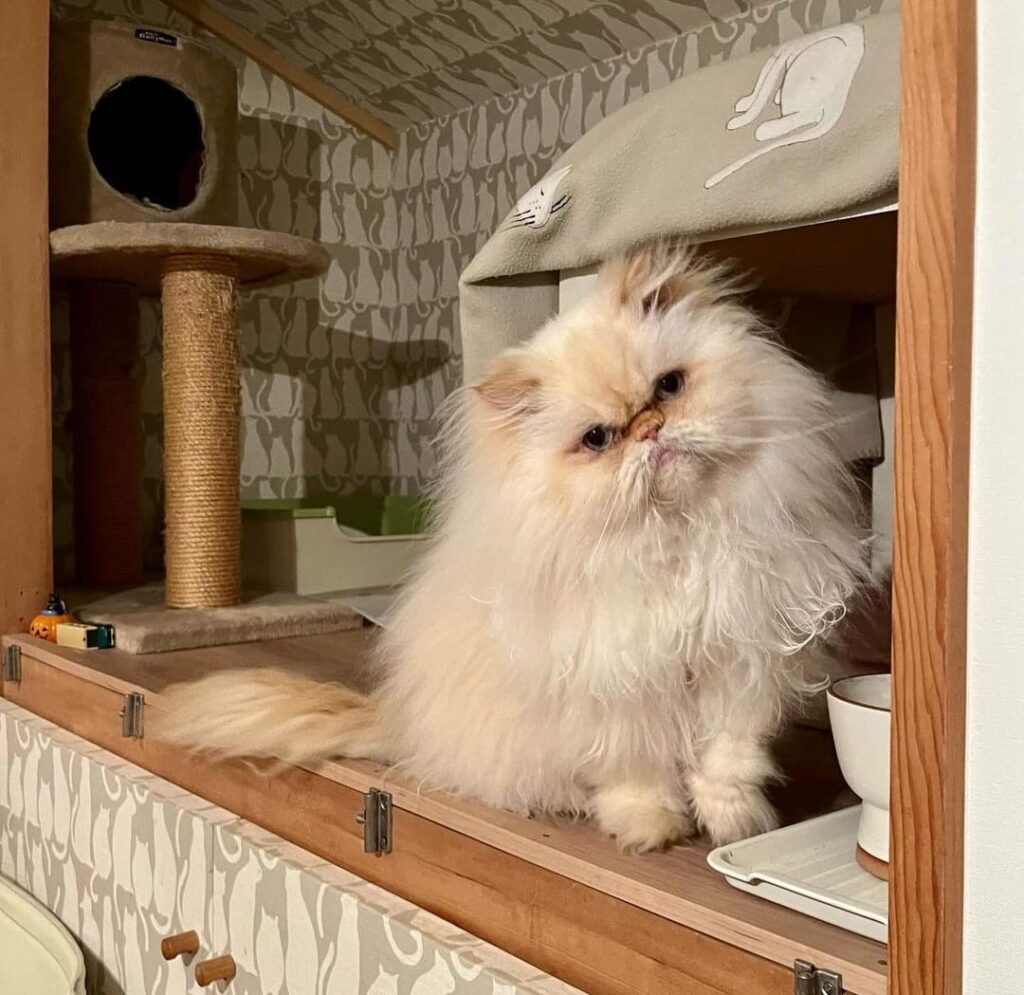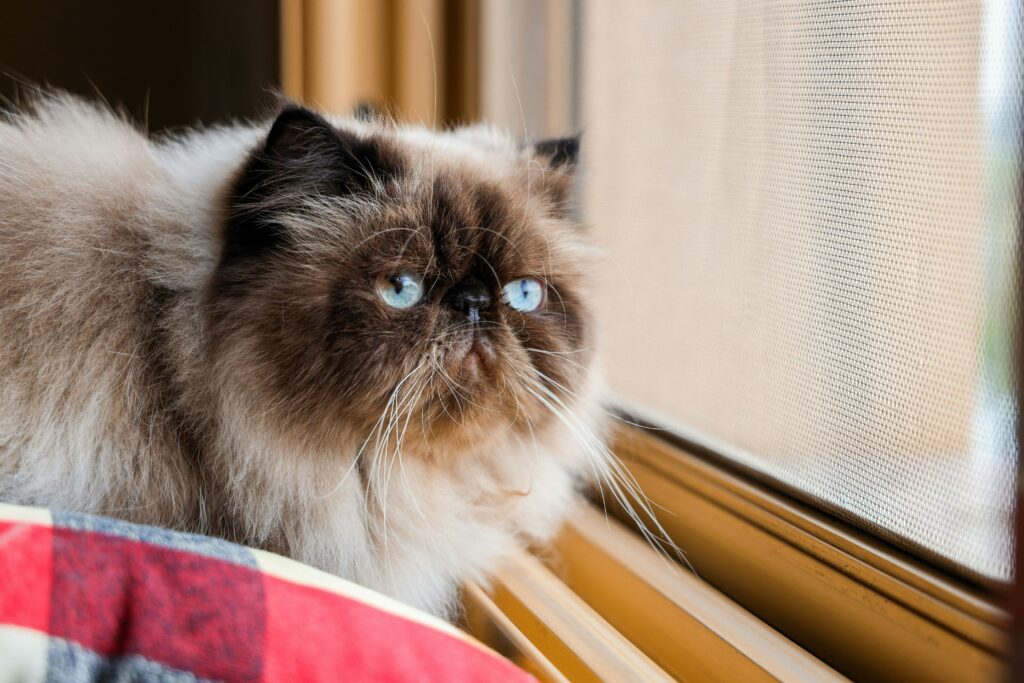Himalayan cats, with their stunning blue eyes and luxurious coats, have captured the hearts of cat enthusiasts around the globe.
Their serene demeanor and striking appearance make them a highly sought-after breed.
This article is dedicated to exploring the world of Himalayan cats, delving into their origins, physical traits, personality, grooming needs, health considerations, and more.

History of the Himalayan Cat Breed
The Himalayan cat breed boasts a fascinating history, blending the best of two worlds: the Persian and Siamese breeds.
This breed emerged in the mid-20th century, thanks to the efforts of breeders who aimed to combine the Persian’s lush coat with the Siamese’s distinctive point coloration. The result was the Himalayan, a breed that exudes elegance and a regal bearing.
Physical Characteristics
Himalayan cats are known for their striking physical attributes. They possess a robust and rounded body, similar to the Persian, with large, expressive blue eyes that are a hallmark of the Siamese influence.
Their fur is long, dense, and silky, requiring regular grooming to maintain its beauty. The point coloration on their faces, ears, paws, and tails adds to their exotic allure.
To know more about the captivating appearance of Himalayan cats, Check out “What Does a Himalayan Cat Look Like? “
Personality and Temperament
Himalayans inherit the best temperament traits from their Persian and Siamese ancestors. They are gentle, calm, and affectionate, often seeking out the company of their human companions.
While they enjoy a peaceful environment, Himalayans also display a playful side, engaging in interactive play with toys or a simple game of chase. Their sweet nature and loyalty make them exceptional pets and companions.
Care and Grooming
The luxurious coat of a Himalayan cat demands regular grooming to stay healthy and mat-free. Daily brushing is essential to prevent tangles and remove loose fur.
Additionally, their eyes may require regular cleaning to avoid tear staining, a common issue due to their facial structure. Establishing a grooming routine early on is key to ensuring your Himalayan’s coat remains in pristine condition.
Health and Common Issues
Himalayan cats share similar health concerns with their Persian counterparts, including polycystic kidney disease (PKD), respiratory issues, and potential for dental malocclusions.
Regular veterinary check-ups and a clean, safe living environment can help mitigate these risks and ensure a healthy, happy life for your Himalayan.
Feeding and Nutrition
A balanced diet is crucial for maintaining the health of a Himalayan cat. High-quality cat food that meets their specific nutritional requirements is recommended. Portion control is important to avoid obesity, a common problem in less active breeds.
Consulting with a veterinarian can help you tailor a feeding plan that supports your cat’s health and vitality.
Training and Exercise
Despite their laid-back nature, Himalayan cats benefit from mental stimulation and physical activity. Engaging them with puzzle toys, scratching posts, and interactive play sessions can help keep them active and prevent boredom.
Training them with positive reinforcement can also enhance their well-being and strengthen your bond.
Living Environment
Himalayan cats thrive in serene and stable environments. They adapt well to apartment living or houses, as long as they have comfortable spaces to relax and observe their surroundings.
Providing them with cozy beds, perches, and window views can greatly enrich their quality of life.
Himalayan Cats as Pets
Choosing a Himalayan cat as a pet means welcoming a gentle, affectionate, and loyal companion into your home. Their needs for grooming and health care are balanced by the deep bonds they form with their owners.
While their fur may require regular maintenance, the joy and companionship they offer are immeasurable.
You May also like – “Are Himalayan Cats Friendly?“
Breeding and Adoption
Responsible breeding practices are essential for Himalayan cats to ensure they are healthy and free from genetic diseases.
Adoption is another wonderful option for those looking to provide a loving home to a Himalayan in need.
Many rescue organizations and shelters have Himalayans and Himalayan mixes waiting for their forever homes.
Before Buying or adopting a Himalayan cat, check out – “Himalayan Cat Buying Guide“
Conclusion
Himalayan cats are not just pets, they are cherished members of the family, offering unconditional love and grace.
Their distinctive looks and endearing personalities make them a delightful addition to any home. With proper care, attention, and love, a Himalayan cat can be a lifelong friend and companion.

FAQs about Himalayan cats
What is special about Himalayan cat?
Himalayan cats are known for their long fur, blue eyes, calm personalities, and Siamese-like color points, blending Persian and Siamese traits.
Are Himalayan cats easy to take care of?
Himalayans need daily grooming, face cleaning, and are prone to certain health issues, requiring attentive care and regular vet visits.
Are Himalayan cats good with children and other pets?
Yes, Himalayan cats are generally good with children and other pets, thanks to their gentle nature. Proper introductions and socialization are key to harmonious relationships.
How often should I groom my Himalayan cat?
Daily brushing is recommended for Himalayan cats to prevent matting and keep their coat in good condition. Regular baths and eye cleaning are also advisable.
Do Himalayan cats have any special dietary needs?
Himalayan cats do not have specific dietary needs different from other breeds, but a balanced diet


